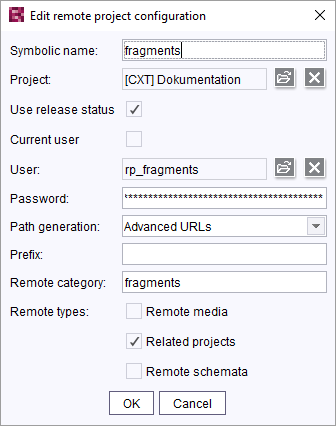Accessing fragments
| Table of contents |
Fragments and variants are small, self-contained units of content that are created, managed, and deployed regardless of context (see FAQ: What are fragments?).
Depending on the application, the following may be desirable:
- To reference fragments from a fragment project in a further fragment project.
Advantages:- No additional memory requirement for fragments used in multiple projects
- Simplified editing and managing since all content is located in a centralized fragment project
- To reference fragments from a fragment project in a conventional FirstSpirit project.
Advantages:- Fragments without any context can be grouped, structured, and placed in relation to each other.
- The fragments remain physically located in the fragment project.
In such cases, what is known as a “remote project configuration” is required (see also Projects).
Prerequisites
So that fragments from other projects can be referenced, the following prerequisites must be met:
What? | Where? | Further information |
|---|---|---|
The “Fragment DAP” module must be installed on the server. | FirstSpirit ServerManager | |
The required projects must have been created on the server. | FirstSpirit ServerManager | see Projects |
Remote project configuration
If a fragment project is to make its content available to other projects, the project must be configured as a “remote project” in the project properties of the target projects (= projects which reference fragments).
To create a new remote configuration, go to “Project properties / Remote projects” in the FirstSpirit ServerManager and click the “Add” button.
Example configuration:

For general information about configuring remote projects, see (Remote projects (→Documentation for Administrators)).
Permission configuration
Use technical user: For DAP access, permission assignment is recommended using technical users / groups. This user or group is defined via the FirstSpirit ServerManager (see Users and roles) and controls the access of one of the target projects to the content of the remote project.
(Different access permissions to a remote project are configured using different remote project configurations in the target project. Multiple technical users or groups can be defined in the process; these users access the same remote project, each with different access permissions.)
For the group / user (here: group “rp_fragments”), the corresponding editorial permissions must then be configured in the remote project (see, for example, Best practice – Permissions and roles)
Use current user: Alternatively, remote access can also be configured for the user who is currently logged in. In this case, the “Current user” box must be checked and the corresponding access permissions must be configured in the remote project.
Additional steps
Following configuration of the remote projects in this way, an input component must be configured in the target projects for the selection of fragments in target projects (FS_INDEX, see Using fragments).

